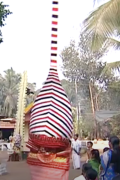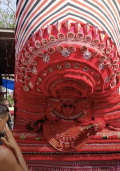In ancient times, the local kings used to divide their territories by dividing their borders for administrative convenience. Such small local kingdoms are called swaroopam. The main swaroopams of North Kerala are Allada swaroopam, Kola swaroopam and Kottayam swaroopam. The old name of Kola swaroopam was Mushika Vansam. Later, for administrative convenience, Kola swaroopam was again divided into smaller swaroopams. The names of these swaroopams are Northern Kutti, Southern Kutti, Nidiyiruppu and Chuzhali. The Samantharamars (rulers) who determined the Kolathiri ruled these smaller swaroopams. In this, the paradeity of Chuzhali swaroopam is Chuzhali Bhagavati.
The legend about Chuzhali Bhagavati is as follows.
It is believed that Chuzhali Bhavathi is a goddess who came to the mountains from Aryan country in a wooden boat. A princess of Arya was bathing in the river with her entourage. At that time, Goddess Durga was entered to the princess’s body. Later, everyone felt different in the princess’s behavior. The king, who was alarmed by his daughter’s actions, called the diviners and inquired about the matter. Thus, according to the diviners’ findings, it was known that the power of God was attracted to the princess’s body.
The goddess had a desire to see the Malanad (Kerala), and accordingly the king summoned Vishwakarma and built a ship of great splendor. The princess set off for the mountains. As the princess boarded the ship, three radiant forms emerged from the princess’s body and boarded the ship.
The ship traveled through the ocean without wind and rain day and night. The mountain country was about to be reached. After passing the Gokarna coast, Kumbala and Ezhimala, the ship approached Cherukun, Aayiramtheng. When the ship approached land, the locals ran away. There was no unusual ship captain. On hearing the news, the rulers of the land, the Neriyottu Kar, the Kolathiris and the Kozhikkilidamdhu heirs arrived there. They found three idols in the ship, and all three took one idol each. The third idol was dim to see. The Kozhikkilidamdhu heir got that idol. But when he took that idol, the ship rose unusually. This made the rulers suspicious.
The people of Kolathiri followed the Kozhikkilidamdhu heir who was carrying the idol. Realizing this, the Kozhikkilidamdhu Samanthar Paramavati walked through the paths and alleys in secret. On the way, he saw a washerman, and realizing that it would not be easy to escape from Kolathiri, the Kozhikkilidamdhu Samanthar devised a trick. He told the washerman that Kolathiri was following him and that he should escape if he wanted his life. Hearing this, the washerman ran away from there. Samanthar, who had wrapped the idol in a washerman’s cloth, tricked Kolathiri by pretending to be a washerman. Later, when Kolathiri left, the heir of the house, Kozhikkilam, set off for his native land with the idol.
The place where the idol was wrapped in a cloth and hidden was the Manakulangara area near Kaliyassery. Samanthar, who had escaped but was not afraid, buried the idol in a place called ‘Vadakke Kavu’, where no one was there. Samanthar, who had bathed and eaten, fell asleep due to exhaustion. In the meantime, he had told his wife everything that had happened related to the idol.
Samanthar woke up in his sleep and felt very short of breath. His wife brought doctors, but Samanthar’s condition was serious and no medicine was effective. Before long, Samanthar died.
The relatives, who knew the story of the idol, called astrologers and investigated the matter. The astrologer said that the goddess’s idol was buried in the ground, which caused the goddess’ anger and that was what led to Samantara’s untimely death. The astrologer decided that the goddess should be enshrined in a temple as a solution to the problem. But no one could find the buried idol for ages.
One day, a farmer who was digging a hole to plant tubers found the idol again. He heard the sound of something hitting the stump, and when he saw an idol and saw blood coming from the stump, the farmer was surprised and ran away from there. The local authorities came to know about it. Samantara, who was in Kozhukkil, where the idol’s past was known, found out about it and took out the idol, built a temple there and installed it.
The Kana family lived near the place where the temple was built, but due to various calamities during the construction of the temple, they left the area where Bhagavathy was present and moved to Payyannur according to the astrological predictions. The place where the Kana family lived later came to be known as Kanai. The Kana family still has the right to perform some rituals during the festivals at the Chuzhali Bhagavathy temple.
This temple later became known as the Chuzhali Bhagavathy temple. Later, the place where the feudal lords lived at Kozhikkilam was also known as Chuzhali Swarupam. This Bhagavathy was called Chuzhannaval and Chuzhali Bhagavathy in the sense that she came from the Aryan country (Kashi) through the ocean to see the Malanadu.
Later, the Theyyakolam of Chuzhali Bhagavathy started being worn in the villages of North Kerala. Chuzhali Bhagavathy Theyyam is a Theyyam who wears a huge braid that will amaze anyone.




